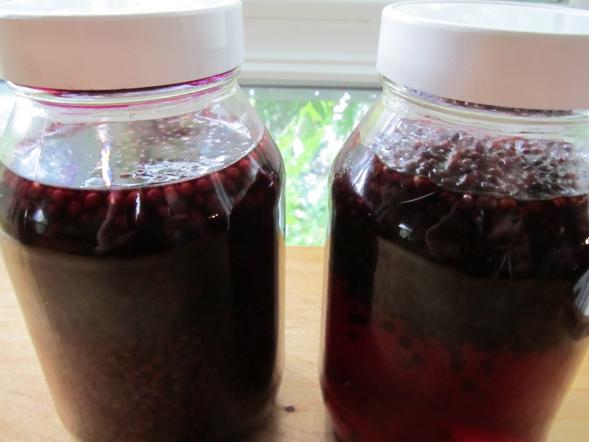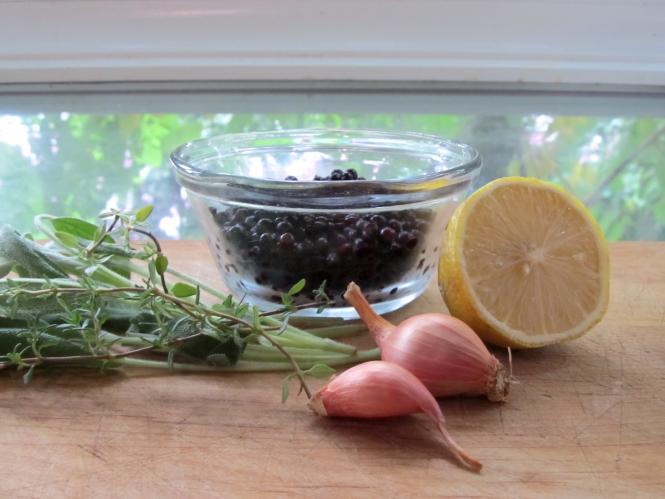Fellow foragers had warned me about elderberries. They cautioned me about the hours of tedious labor the dark purple berries demand. They told me how the stems, unripe red berries and even seeds can be slightly toxic as they contain a compound similar to cyanide, and how almost every stem must be painstakingly removed. I’m glad I didn’t listen to these warnings (or conveniently forgot them) as my grandfather and I struck out on a sunny early autumn afternoon to collect our elderberries from a ditch near the family cabin in northwestern Wisconsin. Visions of pies, jams and medicinal tinctures danced in my head, and the elderberry bush, laden with ripe berries seemed happy to oblige. When I pulled my octogenarian grandfather out of the bramble a half hour later, we had four paper bags full of berries. My grandfather wondered if this bounty would be enough for his jam and my various elderberry dreams. As we began to comb the BB-sized berries from their stems back at the cabin, we realized that we certainly did have enough.
Now, I’ve since read that an “experienced” elderberry harvester (whatever that is) can easily remove stems from two pounds of berries in half an hour. This claim may be true, but all I know is that my grandfather and I put on the old version of “The Great Gatsby” as we hunched uncomfortably over our bowls of berries and by the time Nick Carraway’s summer came to a tragic end, we had barely de-stemed three pounds between us. Our necks ached, our vision blurred and our hands turned a morbid purple but I still think those little gems were worth the pain.
American black elderberry (Sambucus nigra ssp. canadensis) is an exceptional plant because of its wide variety of uses. The deciduous shrub’s European counterpart, Sambucus nigra ssp. nigra, has been used medicinally and in food for centuries throughout Europe, Northern Africa and parts of Asia. The plant’s white flowers can also be made into syrups, cordials, soups and fritters. The clusters of these white flowers can be a good way to identify elder patches for berry harvesting in the fall. Elderberry plants like well-drained, moist soil and a sunny exposure, so look for them outside the city in ditches, fields and by streams. When foraging, make sure to make a correct identification, as other species of elderberry tend to be poisonous.
When my grandfather told me he had found an elderberry patch by the cabin I was thrilled because my friends, family and I have been slurping down elderberry tincture for what ails us for years now and I wanted to try my hand at my own extracts. Elderberries contain potent antioxidants called anthocyancins, which contribute to the berry’s dark purple color. Recent studies have shown that these flavonoids and other constituents of the elderberry may be effective in shortening the duration and severity of certain flu strains. In addition to its anti-viral and anti-oxidant actions, black elderberry works as a decongestant and expectorant and also contains large amounts of vitamin C, which makes its tincture a wintertime must-have. Below is a simple recipe for black elderberry extract. If you’ve missed the window for fresh elderberries, you can use dried berries found at your local co-op or natural foods store.
 Elderberry tincture
Elderberry tincture
Elderberry Tincture
Ingredients:
- 1 quart vodka (I used locally-distilled Prairie Organic Vodka) or Vegetable glycerine
- 1 pint fresh elderberries, washed and with stems removed (or 1 cup dried elderberries)
- Clean quart jar
- Cheesecloth or fine sieve
Instructions:
- Fill jar with elderberries and pour vodka over berries to cover at least one inch.
- Shake jar to remove air bubbles.
- Store jar in a cool, dark place for at least 4-6 weeks, agitating once or twice daily. Pour more vodka over berries to cover, if necessary.
- Squeeze tincture out of berries using a cheesecloth or sieve. Transfer tincture to dropper bottles. The extract with keep for 1-2 years.
To Use: Adults use 30-40 drops 2-4 times daily.
After leaving my tincture to steep, what I really wanted to do was find out what these berries could do in the kitchen. Elderberries make delicious syrups, jams, pies and other pastries, but I thought a savory dish would highlight the berry’s tartness. I immediately thought of pork as suitable companion. I adapted the recipe that follows from this pork chop and blueberry sauce recipe. I served it with roasted brussels sprouts, but I think mashed root vegetables would also work nicely. In the end, all that picking made the dish that much sweeter (or more deliciously tart, in this instance). I hope my grandfather’s jam turns out…
Seared Pork Chops with Savory Elderberry Sauce
Serves 4
Adapted from The Kitchn
Ingredients:
- 4 boneless pork chops (each about a third of a pound)
- 2 shallots, minced
- 2 tablespoons butter
- ½ cup red wine
- ½ cup fresh elderberries, washed and with stems removed (or ¼ dried elderberries)
- ¼ cup water (or ½ cup, if using dried elderberries)
- 2 tablespoons fresh sage
- 2 tablespoons fresh thyme
- 1 teaspoon sugar (optional)
- Grated zest and juice of half a lemon
- Kosher salt
- Freshly ground black pepper
- Olive oil
Instructions:
- Rub both sides of pork chops with olive oil, salt, pepper, 1 tablespoon of the sage and 1 tablespoon of the thyme. Refrigerate for at least 30 minutes.
- Preheat oven to 425°F
- Heat a tablespoon of olive oil in a cast iron pan and sear pork chops over medium-high heat for 1 to 2 minutes on each side. Then, place the pan in the oven and bake chops 10-12 minutes or until cooked through.
- While chops are in the oven, begin the elderberry sauce. Heat a tablespoon of olive oil in a small saucepan. Add shallots and cook until soft and translucent. Add wine, water and sugar and bring to a boil. Add elderberries, lemon zest and juice and the rest of the herbs. Bring to a boil again. Reduce the sauce until thick and syrupy.
- Remove chops from the oven and let rest for about 5 minutes.
- Remove sauce from heat and melt in butter. Salt and pepper sauce to taste.
- Serve pork chops topped with elderberry sauce.

Kelly Kassera grew up in Western Wisconsin, but has been happy to call Minnesota her home for over a decade. She works in the Wellness department at the Linden Hills Co-op. Her passions include reading and writing poetry, environmental writing, and food justice. When she’s not writing or talking about fish oil at the co-op, you can find her east over the border kayaking, drinking beer, and eating cheese curds. Her last article for SGT was Everyone Welcome: The New Seward Co-op and Inclusiveness.

